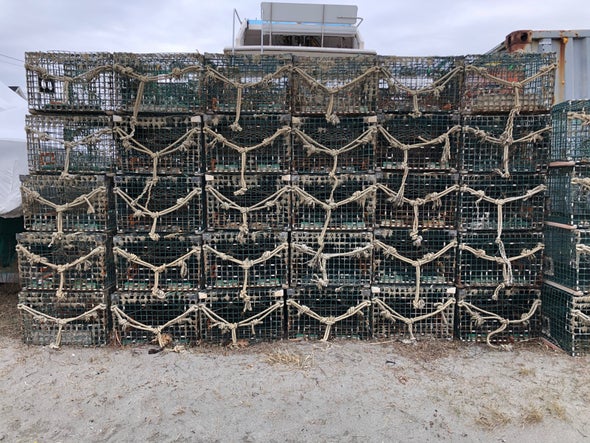(单词翻译:单击)
听力文本
This is Scientific American's 60-second Science. I'm Jason Goldman.
There's a lot of cash crawling on the seafloor. American lobsters bring in more money than any other U.S. fishery—a record $670 million in 2016, mostly through Maine and Massachusetts.
The fishery relies on traditional lobster harvest techniques: a series of traps are dropped to the ocean floor with a long rope attached to a floating buoy.
"During peak fishing season, there's over 900,000 vertical lines right in the middle of right whale habitat."
Graduate student Hannah Myers from the University of Alaska Fairbanks College of Fisheries and Ocean Sciences.
Those vertical lines entangle and kill endangered sea turtles and multiple whale species—including the North Atlantic right whales. Only about 400 individuals remain. And recent analyses show that the species won't survive if humans kill an average of just one whale each year. Some estimates indicate that lobstering gear kills more than three whales each year on average.
"Management problems surrounding the North Atlantic right whale and entanglements are pretty significant and have been really challenging to move forward. And a large part of that is due to expected negative economic impacts on the lobster fishery."

But right whale protections don't have to mean lobster losses. Canada's lobster harvest operates with fewer traps and a shorter, six-month-long season.
"The U.S. lobster fishery in Maine expends approximately 7.5 times as much as the Canadian fishery to catch the same amount. And Canadians are catching almost four times more lobsters per trap."
They're putting less effort into it and spending less on fuel and equipment. But they're still gathering nearly the same amount of lobster overall. And there are stateside examples.
"In Massachusetts, areas that have had a seasonal closure in recent years have reached record-high landings."
The study was published in the journal Marine Policy.
Restrictions could actually mean a healthier lobster population overall.
"It's paradoxical, but it is consistent with a lot of fisheries research that shows that when you fish with too much effort, too many traps in the water, then the stock itself isn't as robust. So one thing we might expect is you would have more or larger lobsters (if there are fewer traps in the water) coming in to each trap. And therefore you would be able to haul up more lobster per trap. And that's kind of what we see on the Canadian side."
Taking some of those ropes out of the water could benefit both the whales and the fishery.
"Our main takeaway is that a negative economic impact should not be assumed with effort reduction in the U.S. lobster fishery."
Thanks for listening for Scientific American's 60-second Science. I'm Jason Goldman.
参考译文
这里是科学美国人——60秒科学。我是杰森·古德曼。
海底遍布财富。美国龙虾带来的收入比美国其他任何水产都要多——2016年达到创纪录的6.7亿美元,其中大多数由缅因州和马萨诸塞州创造。
渔业依赖传统龙虾收获技术:将连有长绳的一连串捕虾笼沉入海底,绳子另一端系在浮标上。
“在捕鱼旺季,露脊鲸栖息地中部立有90多万根竖绳。”
阿拉斯加州大学费尔班克斯渔业与海洋科学学院的研究生汉娜·迈尔斯说到。
这些竖绳缠住并杀死濒临灭绝的海龟和包括北大西洋露脊鲸在内的多种鲸类。目前北大西洋露脊鲸仅剩下约400头。而最近的分析表明,人类平均每年只捕杀一头鲸鱼,就会使这个物种无法生存下去。一些评估表明,捕龙虾装置每年平均杀死三头以上的鲸鱼。
“围绕北大西洋露脊鲸的管理问题和缠绕问题至关重要,这两个问题一直在挑战着渔业的发展。大部分由于人们预期龙虾业会遭到负面经济影响。”
但保护露脊鲸并不一定意味着龙虾业受损。加拿大捕龙虾业采用较少的捕虾笼,并以仅半年的较短捕获时间运作。
“捕相同数量的龙虾,美国缅因州龙虾业花费的花费约为加拿大的7.5倍。而加拿大每个捕虾笼的捕获量大概是美国的4倍。”
他们在这方面投入的精力更少,消耗的能源和装置也更少。但他们捕获的龙虾总量依旧与美国大致持平。以下是美国本土案件。
“在马萨诸塞州近年来季节性关闭的地区,其捕获量达到了历史新高。”
这项研究发表在《海洋政策》期刊上。
限制捕捞实际上意味着龙虾整个群体会更健康。
“这似乎自相矛盾,但这与大量渔业研究的结果相一致,即当过度捕捞、在水中放置过多捕笼时,水产本身就不那么健康了。因此,我们能预料的一件事是,(如果水中少放些捕笼,)就会有更多或更大的龙虾进去。继而就能在每个笼中拖上来更多的龙虾。这就是我们在加拿大看到的模式。”
将水中的竖绳抽出一些,对鲸鱼和渔业都有好处。
“我们的重点是,不应认为美国龙虾捕捞力度减少,就会产生负面经济影响。”
谢谢大家收听科学美国人——60秒科学。我是杰森· 古德曼。
译文为可可英语翻译,未经授权请勿转载!
重点讲解
重点讲解:
1. bring in 赚得,挣(钱);
I have three part-time jobs, which bring in about 14,000 pounds a year.
我有3份兼职工作,一年能挣大约14,000英镑。
2. rely on 依赖;依靠;
Most poultry farmers have to rely on commercially manufactured feeds.
多数饲养家禽的农场主不得不依赖商业化生产的饲料。
3. on average 平均起来;按平均值;
On average, Americans report that they sit between four and a half to five hours a day.
美国人平均每天坐4个半到5个小时。
4. be consistent with (观点等)一致的,吻合的,不矛盾的;
The results are entirely consistent with our earlier research.
这些结果与我们早些时候的研究完全吻合。


